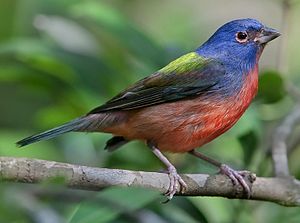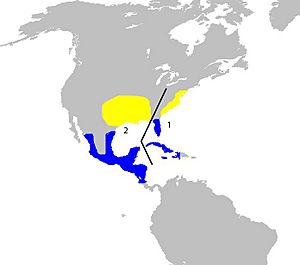Painted bunting facts for kids
Quick facts for kids Painted bunting |
|
|---|---|
 |
|
| Male | |
| Conservation status | |
| Scientific classification | |
| Genus: |
Passerina
|
| Species: |
ciris
|
 |
|
| Range of P. ciris Breeding range Wintering range | |
| Synonyms | |
|
Emberiza ciris Linnaeus, 1758 |
|
The painted bunting (Passerina ciris) is a type of bird in the cardinal family. It lives in North America. The male painted bunting is famous for its super bright feathers. However, these amazing colors only appear when the male bird is about two years old. When they are younger, it's hard to tell them apart from the females without looking very closely.
Contents
About the Painted Bunting
Scientists give every living thing a special name. For the painted bunting, this name is Passerina ciris. A famous scientist named Carl Linnaeus first described this bird way back in 1758.
There are two main types, or subspecies, of the painted bunting:
- P. c. ciris: This group lives and breeds in the southeastern United States.
- P. c. pallidior: This group breeds in the south-central U.S. and northern Mexico.
Appearance and Colors
Many people say the male painted bunting is the most beautiful bird in North America. It's even called "nonpareil," which means "without equal." Its feathers are a mix of bright colors: a dark blue head, a green back, and a red bottom part. These colors make it easy to spot, but the bird can still be hard to see because it often hides in leaves, even when it's singing.
Female and young painted buntings are mostly green and yellow-green. This helps them blend in with their surroundings, like a natural camouflage. Even so, an adult female is still special because her green is brighter than other similar songbirds.
Adult painted buntings are about 12 to 14 centimeters (5 inches) long. Their wings can spread out to 21 to 23 centimeters (9 inches). They usually weigh between 13 and 19 grams (less than an ounce). Young birds change their feathers twice in their first autumn. Each time, their new feathers look like those of an adult female.
Where They Live and Their Home
Painted buntings like to live in places with lots of bushes and trees. You can often find them at the edges of woodlands, near rivers, or in gardens with thick plants. In the eastern parts of their range, they live in coastal forests and bushy areas. Sometimes, you can even see them along roadsides or in suburban gardens.
During winter, they move to warmer places. They prefer the bushy edges of tropical forests or grassy areas with scattered trees.
The painted bunting's breeding areas are split into two separate regions. One is in the southwestern U.S., including southern Arizona, New Mexico, and parts of Texas. The other is in the southeastern U.S., covering parts of Oklahoma, Arkansas, Louisiana, northern Florida, coastal Georgia, and South Carolina. They also breed in northern Mexico.
For winter, these birds fly to South Florida, Cuba, the Bahamas, and along the coasts of Mexico. They also spend winter throughout much of Central America. Sometimes, a few birds might wander further north to places like New York or Pennsylvania.
Behavior and Habits
Painted buntings are usually shy and like to stay hidden. This can make them hard to see. However, if they get used to bird feeders, they can become quite friendly.
In spring, male buntings sing from high spots to show other birds where their territory is. They also do special dances and flights to impress females or to warn other males. These displays can include flying like a butterfly or puffing up their bodies. Sometimes, males might even fight each other, but this is rare.
After their breeding season ends, buntings fly shorter distances at night to their winter homes.
What They Eat
Painted buntings often hop along the ground to find food. They stop often to look around carefully. In winter, they mostly eat a lot of grass seeds. These include seeds from plants like Panicum, Amararanthus, and Carex.
When they are breeding, painted buntings and their babies mainly eat small invertebrates. This includes spiders, snails, grasshoppers, and other insects. They have even been seen visiting spider webs to pick off tiny insects caught there.
Reproduction and Life Cycle
Painted buntings usually have one partner during the breeding season. However, sometimes a male might have more than one female partner. The breeding season starts in late April and lasts until early August.
The male bird arrives about a week before the female to find and claim a small area. The female builds the nest, usually hidden in low, thick plants. She weaves the nest into the plants to make it strong. Each nest usually has three or four gray-white eggs, which often have brown spots. The female sits on the eggs for about 10 days until the babies hatch. Only the female takes care of the young birds.
The baby birds stay in the nest for about 12 to 14 days. Then, they are ready to fly out on their own. About a month after the first eggs hatch, the female painted bunting usually lays a second set of eggs.
Sometimes, other birds like cowbirds lay their eggs in a bunting's nest, making the bunting raise the cowbird babies. Snakes, like coachwhip snakes and eastern kingsnakes, are common predators that eat eggs, young birds, and even female buntings on the nest.
Painted buntings can live for over 10 years. However, most wild buntings probably live for about half that time.
Status and Protection
In the past, male painted buntings were often caught and kept as pet birds because of their beautiful colors. But now, catching and keeping them is against the law. However, some trapping for sale overseas might still happen in Central America.
The main reason painted bunting numbers are going down is because their homes are being destroyed by new buildings and developments. This is especially true in coastal swamp areas and woodlands in the east, and along rivers where they stop during migration in the southeastern U.S. and Mexico.
The painted bunting is protected by the U.S. Migratory Bird Act. This law helps protect them from being hunted or captured.
Images for kids
-
Male painted bunting in Quintana, Texas
-
Painted Bunting from The Birds of America
See also
 In Spanish: Azulillo sietecolores para niños
In Spanish: Azulillo sietecolores para niños







